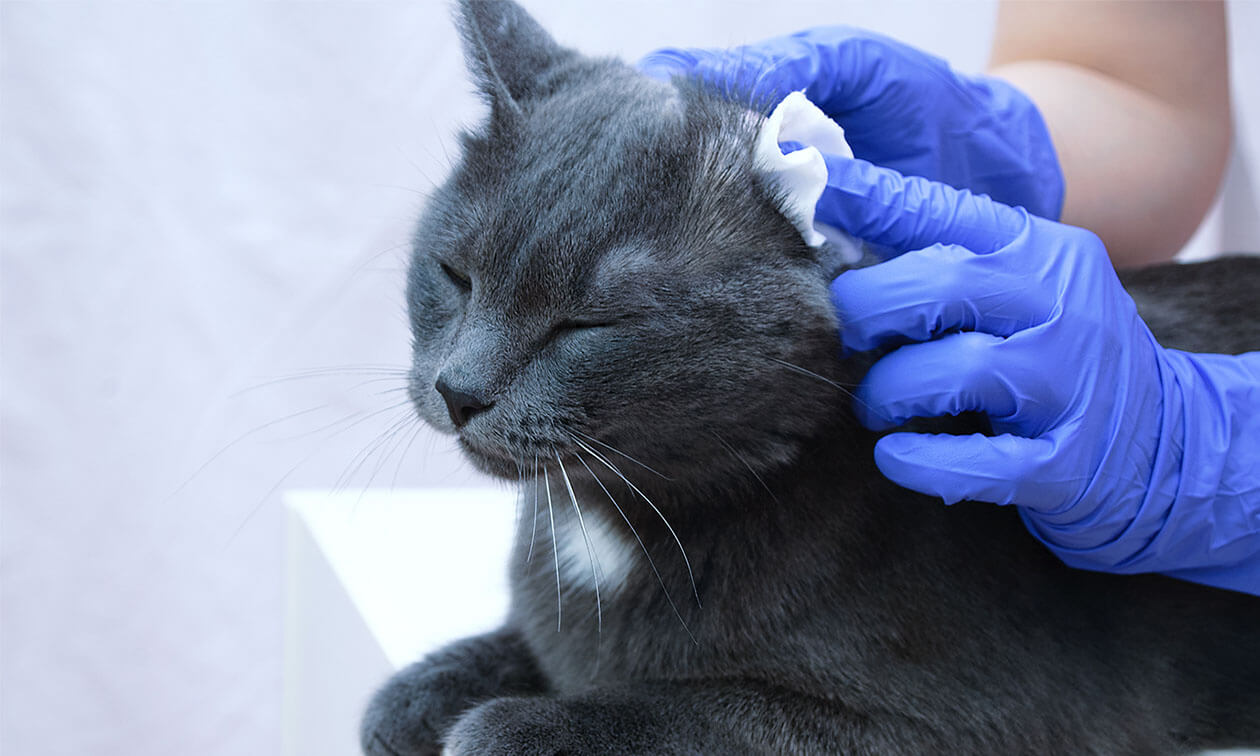Ear mites, also known as Otodectes cynotis, are common in cats. Knowing how your cat can get ear mites and recognizing the signs will help you provide prompt treatment and avoid complications.
What Do Cat Ear Mites Look Like?
Ear mites are a common parasite. They’re about the size of a grain of sand, barely visible to the naked eye. They can’t fly or hop but instead crawl — you may even be able to see them as moving, tiny, white specks. Ear mites are typically present within the ear canal, but can also be seen on the surrounding skin and other parts of the body. Under a microscope, they have brown-red oval-shaped bodies with six legs with suckers on the ends.
How Do Cats Get Ear Mites?
Ear mites can be found in cats of any age, but are most common in younger outdoor cats. They are very contagious.
Outdoor cats are most vulnerable, but indoor cats can also get ear mites. As many as 25% of pet cats can be infested.1
Ear mites spread quickly and easily during social interactions with infected cats, such as playing, grooming, sleeping, and fighting. Ear mites can also be spread between cats and dogs.
Signs of Ear Mites in Cats
Ear mites are the most common cause of otitis, which is an inflammation of the ear canal. Unlike other parasites, the number of mites won’t necessarily impact the severity of your cat’s signs of otitis.2
Recognizing the signs of ear mite infestations is important because long-term damage can occur if left untreated.
The typical signs of ear mite infestations in cats include:
- Intense itchiness causing non-stop scratching of the ears
- Head shaking
- Inflamed outer ear (pinna)
- Ears held flat against the head
- Dark, gooey, foul-smelling wax and debris found at the entrance to the ear canal
Because the mites can be seen on other parts of the body, such as the neck, rump, and tail, cats may have signs of itchiness and rash in those locations. Signs can resemble those of a flea bite, food hypersensitivity, or environmental allergies. So, if your cat is suspected of having any of these, get them checked for ear mites as well.
Sometimes cats can have ear mites without showing any clinical signs. This happens in about 10% of cats.1 While your cat may not be displaying signs or feeling obvious discomfort, these mites can lead to future infestations. That’s why it’s important to regularly have your cat’s ears examined by your veterinarian, especially if they spend time outdoors.
Treatment for Ear Mites in Cats
Your veterinarian can easily diagnose your cat by examining the inner ear. In cases where there is excessive debris in the ear, they will use a cotton swab to take a sample and view it under a microscope to make a diagnosis.
The first step in treatment involves thoroughly cleaning the ear canals with a cleaning agent that soothes and softens the skin, as well as dissolving ear wax.
Once the ear canals are cleaned, various ear medications can be used to treat ear mites. Your veterinarian may also need to treat other problems created by the ear mites, such as yeast or bacterial infections.
Treatment can take 14 to 21 days, depending on the medications used and whether there are other concurrent infections.
Because ear mites are highly contagious, all pets in the household should also be treated even if they aren’t showing signs.
How to Prevent Ear Mites in Cats
There are parasiticides your veterinarian can recommend for your cat to prevent future ear mite infestations.
ZPC-02581
IMPORTANT SAFETY INFORMATION: The safe use of Revolution Plus has not been established in kittens less than 8 weeks old or in breeding, pregnant or lactating cats. Reported side effects in clinical trials included lethargy and anorexia. Use with caution in cats with a history of neurologic disorders. Revolution Plus contains sarolaner, a member of the isoxazoline class which has been associated with neurologic adverse reactions, such as tremors, ataxia, and seizures in cats with or without a history of neurologic disorders. In humans, Revolution Plus may be irritating to skin and eyes. See Prescribing Information.
REVOLUTION PLUS is indicated for the prevention of heartworm disease caused by Dirofilaria immitis, the treatment and control of roundworm (Toxocara cati) and intestinal hookworm (Ancylostoma tubaeforme) infections, and the treatment and control of ear mite (Otodectes cynotis) infestations. REVOLUTION PLUS kills adult fleas (Ctenocephalides felis) and is indicated for the treatment and prevention of flea infestations, the prevention of Dipylidium caninum (tapeworm) infections as a direct result of killing Ctenocephalides felis vector fleas on the treated cat, and the treatment and control of tick infestations with Amblyomma americanum (lone star tick), Amblyomma maculatum (Gulf Coast tick), Dermacentor variabilis (American dog tick), and Ixodes scapularis (black-legged tick) for one month in cats and kittens 8 weeks and older, and weighing 2.8 pounds or greater.
1. Ear Mites: Uncovering, Treating and Preventing Infestation. Today’s Veterinary Practice. https://todaysveterinarypractice.com/parasitology/ear-mites-uncovering-treating-and-preventing-infestations/. Accessed February 10, 2025.
2. Tackling feline ear disease, dermatophytosis. DVM 360. https://www.dvm360.com/view/tackling-feline-ear-disease-dermatophytosis. Accessed February 10, 2025.




